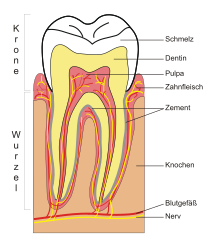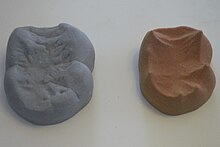Dentine
The dentin (from Latin dens , tooth '(genitive: dentis) and the chemical suffix -in), and dentin ( Latin substantia eburnea ), provides a large proportion of the tooth is in contrast to. Enamel it can live long through a process of Biomineralization can be newly formed, but only at the interface with the pulp . It is one of the most enduring organic materials and all classes of vertebrates that emerged from the cartilaginous fish carry dentin genes.
Tooth structure
The dentine is similar to bone and is made up of approx. 70% mineral matter and 20% organic components. The remaining 10% is water . The mineral substance consists mainly of calcium hydroxyapatite , a calcium -containing phosphate mineral . The organic matter consists of 90% collagen . The color is yellowish. In the area of the tooth crown , the enamel rests on it ("crown tendin") and in the area of the tooth root the root cement . The dentin encloses the pulp cavity (pulp cavity) with the tooth pulp (tooth pulp ), which consists of blood vessels, nerves, connective tissue and lymph vessels .
Dentin proteins
Dentin proteins are poorly characterized because they are anchored in a very solid matrix and can hardly be examined non-destructively. As in bone, type I collagen , acidic proteins and proteoglycans make up a large proportion of extracellular proteins. Some collagen-free protein fractions were due to their molecular mass separated are: Group I having predominantly phosphoproteins , Fraction II acidic with several proteins, albumin , proteoglycans and a protein with a low phosphate content , Fraction III with a characteristic glycoprotein having a molecular mass of 95 kDa and minor amounts of other proteins, including albumin and phosphoproteins as well as fraction IV with low molecular weight fractions of γ-carboxyglutamate -containing proteins that resemble bone proteins.
education
The dentin-forming cells are called odontoblasts . The odontoblast bodies lie in the pulp and are in contact with free nerve endings. Their extensions, the Tomes fibers , protrude into the fine tubules ( dentinal tubules ) that run centrifugally from the pulp outwards to the enamel-dentine boundary.
Depending on the time of formation, three types of dentin are distinguished. Dentin produced during tooth formation is called "primary dentin". The “secondary dentine” is structurally the same. This is formed throughout life and thus narrows the pulp cavity over the years. This reduces the sensitivity of the teeth in old age. Histologically, it is to be differentiated from “tertiary dentine”, also called irritant dentine. It does not develop evenly over the entire area of the odontoblasts, but is formed due to an external stimulus to protect the pulp. In addition to caries , the causes are bruxism , exposed tooth necks and periodontal disease .
The circumpulpal dentin forms the main part of the dentin and occurs after the mantle dentin. The odontoblastic processes here have a smaller number of side branches than in the mantle dentine. Since the mineralization of the dentin occurs in cycles, a typical line pattern is formed. These lines are called Ebner lines after the Austrian histologist Viktor von Ebner-Rofenstein (1842–1925). Correspondingly, the circumpulpal dentine is also called Ebner dentine. The Owen contour lines are called the clearly hypomineralized growth dentine.
Occurrence
Dentin occurs in the phylogenetic history of the scales and teeth of cartilaginous fish ( ganoid scale , cosmoid scale or placoid scale ) and was scientifically described there as early as the 19th century. It can be formed by most of the vertebrates that cartilaginous fish had as ancestors. Although recent and extinct birds have not had teeth for around 60 million years, the dentin matrix protein 1 (DMP1) gene has also been detected in them.
Significance for paleontology
Due to the durability of dentin, teeth are among the most permanent relics of vertebrates and, due to their good state of preservation, often allow their paleontological identification. The phylogenetic examination of tooth development usually allows insight into changes in nutritional behavior. By analyzing traces of use on human ancestors' teeth , it is possible to draw conclusions about certain lifestyle habits such as preferred food and tool use.
Web links
Individual evidence
- ^ Brian R. Lawn, James JW. Lee, and Herzl Chai: Teeth: among nature's most durable biocomposites . In: Annual Review of Materials Research . 40, 2010, pp. 55-75.
- ↑ William T. Butler, Helena H. Ritchie, and ALJJ Bronckers: Extracellular matrix proteins of dentine . In: Dental enamel . 1996, 1997, p. 107.
- ↑ WT Butler, et al. : Nonocollagenous proteins of dentin. Isolation and partial characterization of rat dentin proteins and proteoglycans using a three-step preparative method . In: Collagen and related research . 1, No. 2, 1981, p. 187.
- ↑ H. Kawasaki, et al. : Chemical nature of proteins in the placoid scale of the blue shark, Prionace glauca L. . In: Archives of Oral Biology . 25, No. 5, 1980, pp. 313-320. doi : 10.1016 / 0003-9969 (80) 90040-0 .
- ^ Carl Gegenbaur: Elements of comparative anatomy . Macmillan and Co., 1878 (English).
- ↑ YiPing Chen, et al. : Conservation of early odontogenic signaling pathways in aves . In: Proceedings of the National Academy of Sciences . 97, No. 18, 2000, pp. 10044-10049. doi : 10.1073 / pnas.160245097 .
- ↑ Julia Fritz, Ellen Kienzle, Jürgen Hummel, Oliver Wings, W. Jürgen Streich, Marcus Clauss: Gizzard vs. teeth, it's a tie: food processing efficiency in herbivorous birds and mammals and implications for dinosaur feeding strategies. In: Paleobiology. 37, 2011, pp. 577-586, doi: 10.1666 / 10031.1 .
- ↑ Terry Harrison: A new species of Micropithecus from the middle Miocene of Kenya . In: Journal of Human Evolution . 18, No. 6, 1989, pp. 537-557. doi : 10.1016 / 0047-2484 (89) 90017-1 .
- ↑ Konstanze Weltersbach: Homo neanderthalensis and primitive man: Reconstructions and images of life Archived from the original on August 30, 2011. (PDF) In: Negotiations on the history and theory of biology . 13, 2007, pp. 55-69.



